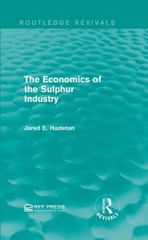Question
Suppose a monopoly drug manufacturer faces the following inverse demand curves for its product in two different countries 1 and 2. Inverse demand curve in
Suppose a monopoly drug manufacturer faces the following inverse demand curves for its product in two different countries 1 and 2.
Inverse demand curve in country 1: p1 = 200 - Q1
Inverse demand curve in country 2: p2 = 180 - 0.5Q2
where pi and Qi denote price and quantity sold in country i respectively and i = 1, 2. The monopolist's cost function is given by
c(Q) = 0.25Q2
where Q = Q1 + Q2. Assume that resale between the countries is not possible and the monopolist maximizes profits.
(a) Find p1 and p2 that maximizes monopolist's profits
(b) Suppose the monopoly drug manufacturer in (a) faces a capacity constraint of 130 units. That is, Q1 + Q2 = 130. What price will the monopolist charge in country 1? What price will the monopolist charge in country 2?
(c) Suppose there are no capacity constraints, but unlike in parts (a) and (b), price discrimination is not allowed. That is, the monopolist cannot charge two different prices in countries 1 and 2. Find the unique price that maximizes monopolist's joint profits (i.e., the sum of profits in the two countries).
Step by Step Solution
There are 3 Steps involved in it
Step: 1

Get Instant Access to Expert-Tailored Solutions
See step-by-step solutions with expert insights and AI powered tools for academic success
Step: 2

Step: 3

Ace Your Homework with AI
Get the answers you need in no time with our AI-driven, step-by-step assistance
Get Started


